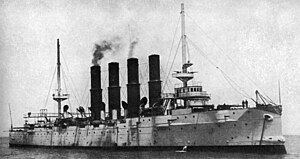Russian cruiser Varyag (1899)

Varyag circa 1904
|
|
| History | |
|---|---|
|
|
|
| Name: | Varyag |
| Builder: | William Cramp and Sons, Philadelphia |
| Laid down: | October 1898 |
| Launched: | 31 October 1899 |
| Commissioned: | 2 January 1901 |
| Fate: | Scuttled 9 February 1904 |
|
|
|
| Name: | Soya |
| Acquired: | by Japan as prize of war |
| Commissioned: | 9 July 1907 |
| Fate: | Returned to Russia, 5 April 1916 |
|
|
|
| Name: | Varyag |
| Acquired: | 5 April 1916 |
| Out of service: | seized by Great Britain February 1918 |
| Fate: | Ran aground 1920, scrapped 1925 |
| General characteristics | |
| Type: | Protected cruiser |
| Displacement: | 6,500 long tons (6,604 t) |
| Length: | 129.6 m (425 ft 2 in) w/l |
| Beam: | 15.8 m (51 ft 10 in) |
| Draught: | 6.3 m (20 ft 8 in) |
| Propulsion: |
|
| Speed: | 23 knots (26 mph; 43 km/h) |
| Complement: | 570 |
| Armament: |
|
Varyag (also spelled Variag; see Varangian for the meaning of the name) (Russian: кре́йсер «Варя́г») was a Russian protected cruiser. Varyag became famous for her crew's stoicism at the Battle of Chemulpo Bay.
The Imperial Admiralty contracted William Cramp and Sons of Philadelphia to build the ship, and her keel was laid in October 1898. Launched on 31 October 1899, under Captain Vladimir Behr, she was commissioned into the Imperial Russian Navy on 2 January 1901.
During her construction, an assistant physician, Leo Alexandroff, left the ship's advance party on 20 April 1899, and applied for U.S. citizenship. He was arrested for desertion. His case reached the United States Supreme Court, which ruled in Tucker v. Alexandroff that the ship, though not accepted for service in the Imperial Russian Navy, was a warship under the terms of the 1832 treaty between Russia and the United States.
During the Battle of Chemulpo Bay at the start of the Russo-Japanese War, Varyag (under the command of Captain of the First Rank Vsevolod Rudnev) accepted a badly unequal battle with the Japanese squadron of Admiral Uriu (one armoured cruiser, five protected cruisers and eight destroyers) in a heroic attempt to break out from Chemulpo (Incheon) harbour 9 February 1904. Chemulpo was in neutral Korean waters. Admiral Uriu gave the Russian ships in harbor a written ultimatum to sail by 12:00 noon or be attacked in the harbor itself. Captain Rudnev sortied, accompanied by the gunboat Koreets; having lost 31 men dead, 191 injured (out of 570) and outgunned, both ships returned to harbor by 1:00 p.m., the crew decided not to surrender, but to sink the ship. The crew was saved by transferring them to the British cruiser Talbot, the French cruiser Pascal, and the Italian cruiser Elba; the captain of the US gunboat Vicksburg declined doing so as a violation of U.S. neutrality.
...
Wikipedia
